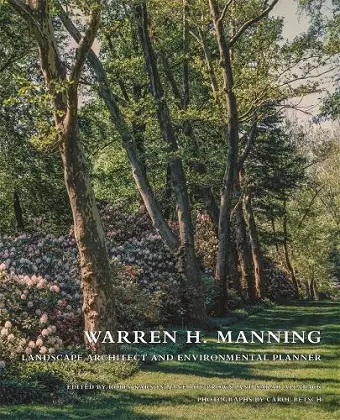Warren H. Manning
Landscape Architect and Environmental Planner
Carol Betsch illustrator Robin Karson editor Jane Roy Brown editor Sarah Allaback editor
Format:Hardback
Publisher:University of Georgia Press
Published:1st Apr '17
Currently unavailable, and unfortunately no date known when it will be back

An in-depth, critical career retrospective of a founder of the American Society of Landscape Architects
Manning Research Project have worked more than a decade to assess current conditions of his built projects and to compile a richly illustrated compendium of site essays that illuminate the range, scope, and significance of Manning’s notable career with specially commissioned photographs by Carol Betsch.
Warren H. Manning’s (1860–1938) national practice comprised more than sixteen hundred landscape design and planning projects throughout North America, from small home grounds to estates, cemeteries, college campuses, parks and park systems, and new industrial towns. Manning approached his design and planning projects from an environmental perspective, conceptualizing projects as components of larger regional (in some cases, national) systems, a method that contrasted sharply with those of his stylistically oriented colleagues. In this regard, as in many others, Manning had been influenced by his years with the Olmsted firm, where the foundations of his resource-based approach to design were forged. Manning’s overlay map methods, later adopted by the renowned landscape architect Ian McHarg, providedthe basis for computer mapping software in widespread use today.
One of the eleven founders of the American Society of Landscape Architects, Manning also ran one of the nation’s largest offices, where he trained several influential designers, including Fletcher Steele, A. D. Taylor, Charles Gillette, and Dan Kiley. After Manning’s death, his reputation slipped into obscurity. Contributors to the Warren H. Manning Research Project have worked more than a decade to assess current conditions of his built projects and to compile a richly illustrated compendium of site essays that illuminate the range, scope, and significance of Manning’s notable career with specially commissioned photographs by Carol Betsch.
Casual readers will be delighted to discover how many of his projects they are familiar with, and practitioners and professionals will find this to be an invaluable guide to what is known about Manning's life and work, and what remains to be discovered.
* Choice Connect *Manning's always been something of a cipher in landscape architectural history, and this book does a good job in clearing away some of the murkiness that has existed around him and his career. The overview essay, in particular, provides new insights into Manning's life, personality, and motivations; it also sheds light into the nature of 'office practice' in the profession's early years, as Manning moves from junior designer at the Olmsted firm to sole practitioner.
* Iowa State University *Manning's importance comes across in his dedication to understanding the environment of particular areas and regions and thinking about broader environmental planning objectives in his projects. With absorbing source material such as the projects found in this publication, future scholars and historians can immerse themselves in Manning's built work and continue to elucidate various aspects of his career, expanding our understanding of this significant figure for American landscape and planning history.
* Landscape Architecture MagaziISBN: 9780820350660
Dimensions: unknown
Weight: unknown
416 pages